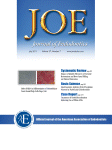Comparative Evaluation of Propolis and Triantibiotic Mixture as an Intracanal Medicament against Enterococcus faecalis
Journal of Endodontics, Article in Press
Introduction
The aim of this study was to evaluate and compare the antimicrobial activity of calcium hydroxide, triantibiotic mixture (TAM), and an ethanol extract of propolis as intracanal medicaments on Enterococcus faecalis–infected root canals.
Methods
One hundred twenty extracted intact human permanent incisors were decoronated, and chemomechanical preparation of the root canal was performed. After sterilization of the samples, they were inoculated with pure culture of E. faecalis and incubated. After incubation, colony-forming units were recorded before medication. Then, samples were divided randomly into five groups (n = 24). Each group was then exposed to various intracanal medicaments, namely calcium hydroxide (group 1), TAM (group 2), propolis (group 3), ethanol (group 4), and saline as the control group (group V). The antibacterial effectiveness of the different intracanal medicament was recorded by determining the percentage reduction in colony counts (%RCC) at the end of days 1, 2, and 7. The data were statistically analyzed using one-way analysis of variance and Tukey Honestly Significant Difference (HSD) post hoc test.
Results
The %RCC was highest for propolis showing 100% reduction on day 2 followed by TAM showing 82.5%, 92.2%, and 98.4% of reduction on days 1, 2, and 3, respectively. Calcium hydroxide showed a gradual increase in antibacterial activity with a maximum of 59.4% on day 7.
Conclusions
Propolis was more effective than TAM against E. faecalis at a 2-day time period, and both were equally effective at 7 days.
Wednesday, July 20, 2011
Subscribe to:
Post Comments (Atom)

No comments:
Post a Comment